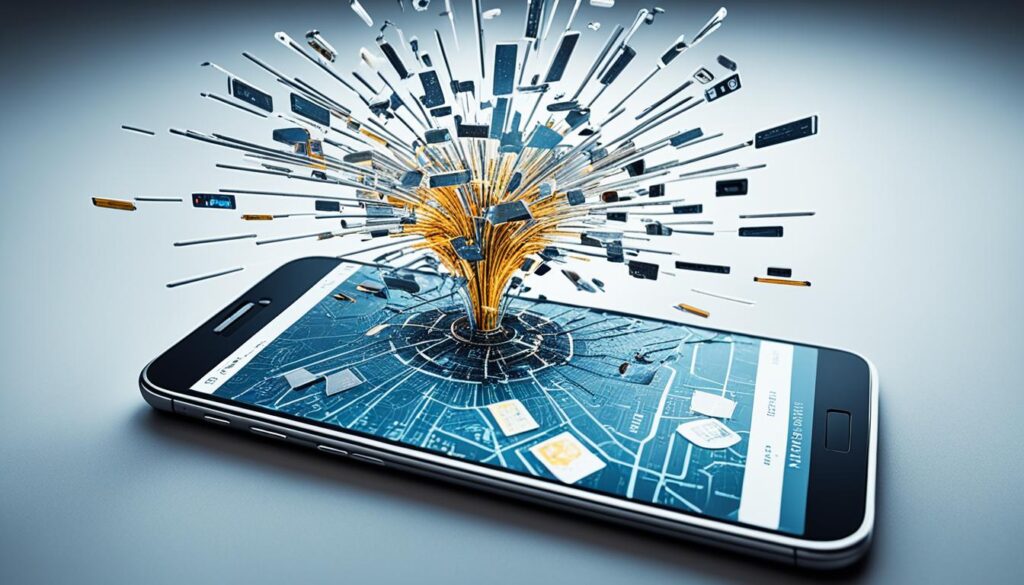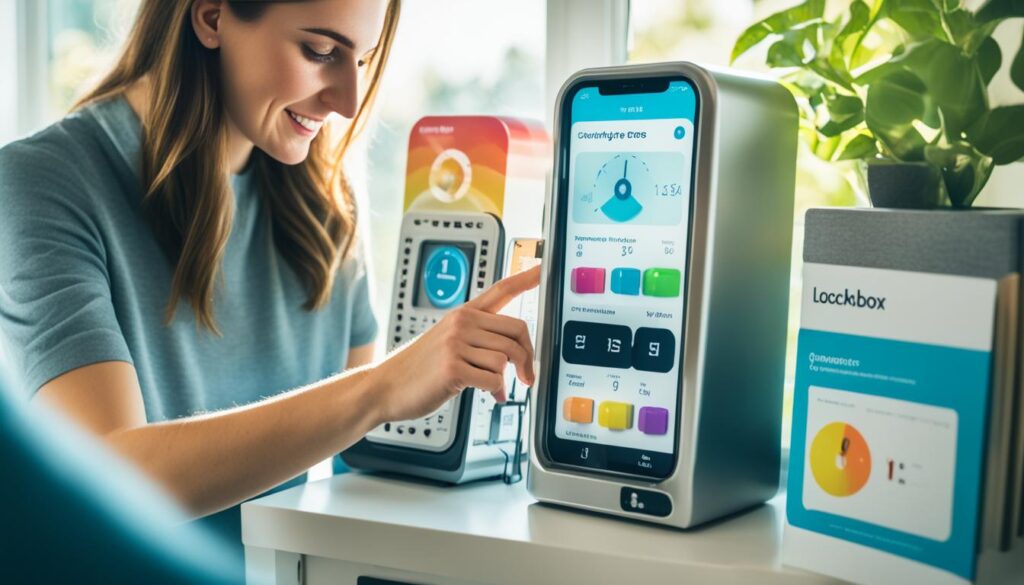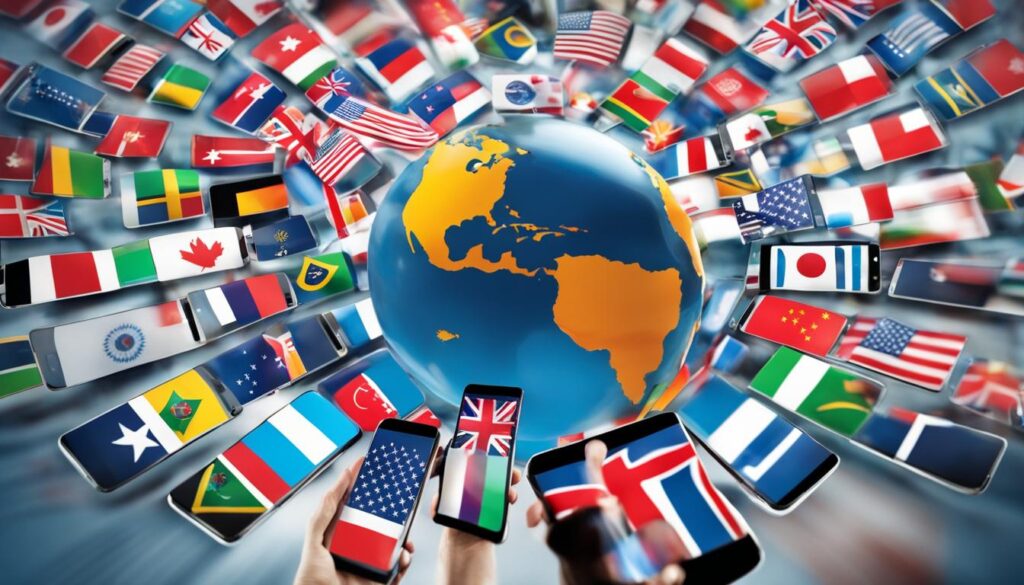Smartphones & Societal Issues:
Did you know that there are currently over 3.8 billion smartphone users worldwide? This astonishing statistic highlights the immense impact that smartphones have on society and the far-reaching consequences of their widespread use.
In this article, we will explore the intricate relationship between smartphones and social issues. From the psychological impacts on communication to privacy concerns and environmental implications, we will uncover the various ways in which smartphones shape our world.
Key Takeaways:
- Smartphones have become an integral part of modern society, with over 3.8 billion users worldwide.
- Smartphones affect various aspects of society, including communication, privacy, the environment, and social inequalities.
- Understanding the consequences of smartphone use is crucial for both individuals and policymakers to address the challenges and promote responsible usage.
- Mitigating distractions, setting boundaries, and fostering mindful smartphone usage can help individuals maintain a healthy relationship with technology.
- Designing a future where technology and humanity coexist requires a collective effort, including policy changes, community initiatives, and ethical considerations.
Introduction to the Pervasiveness of Smartphones in Modern Society
In today’s interconnected world, smartphones have become an integral part of our daily lives. The rise of smartphone usage across demographics has transformed these devices from luxury items to ubiquitous necessities. With their diverse range of core functions, smartphones have revolutionized the way we communicate, access information, and navigate the world around us.
The Rise of Smartphone Usage Across Demographics
Smartphone usage has witnessed exponential growth across all age groups and socioeconomic backgrounds. From teenagers to senior citizens, people from every demographic have embraced smartphones as essential tools for communication, entertainment, and productivity. Whether it’s texting, calling, or browsing the internet, smartphones have become indispensable in our increasingly connected society.
Smartphones: From Luxury to Ubiquitous Necessity
Gone are the days when smartphones were considered extravagant gadgets. With advancements in technology and increased affordability, smartphones have become accessible to a significant portion of the population. What was once a luxury item reserved for the affluent has now become a ubiquitous necessity, empowering individuals from all walks of life.
Understanding the Core Functions of Today’s Smartphones
One of the key reasons for the widespread adoption of smartphones is their versatile range of core functions. From making phone calls and sending text messages to capturing high-quality photos, navigating through apps, and accessing the internet, smartphones offer a myriad of capabilities in the palm of our hands. Additionally, smartphones serve as portable media players, GPS navigation devices, digital wallets, and even fitness trackers, further enhancing their indispensability in our daily lives.
The Psychological Impacts of Smartphones on Communication

Smartphones have ushered in a new era of communication, revolutionizing the way we interact with one another. However, this technological advancement has not been without its consequences. The psychological impacts of smartphones on communication have become increasingly apparent, with significant changes in interpersonal interactions and conversational depth.
Alterations in Interpersonal Interactions and Conversational Depth
With the advent of smartphones, our interactions with others have become more fragmented and superficial. The constant need to stay connected through messaging apps and social media platforms has led to shorter and more frequent exchanges, often devoid of the depth and nuance that face-to-face conversations offer. As a result, the quality of our interpersonal interactions has been compromised, leading to a loss of emotional connection and empathy.
Furthermore, smartphones have altered the dynamics of conversation by introducing distractions. It is not uncommon to witness individuals engrossed in their smartphones while in the presence of others, interrupting the flow of communication and hindering active listening. This constant partial attention can diminish the quality of our conversations and limit our ability to connect on a deeper level.
Smartphones and the Decline of Face-to-Face Communication Skills
In the age of smartphones, face-to-face communication skills have experienced a decline. The ease and convenience of digital communication have led to a decreased emphasis on the importance of nonverbal cues, such as facial expressions and body language, which are essential components of effective communication.
Additionally, the reliance on texting and messaging has limited opportunities for individuals to practice and develop crucial communication skills, such as active listening, conflict resolution, and empathy. Without regular face-to-face interactions, our ability to navigate complex social situations and build meaningful relationships may be impaired.
It is essential to recognize and address the psychological impacts of smartphones on communication to foster healthier and more meaningful connections in the digital age. By setting boundaries, practicing mindful usage, and prioritizing face-to-face interactions, we can strive to reestablish the depth and richness of communication that smartphones have inadvertently undermined.
How could smartphones be linked to societal problems?
Smartphones have become an integral part of modern society, revolutionizing the way we communicate, work, and access information. However, their widespread usage has also brought about a range of negative consequences that impact various aspects of society.
One of the most prominent societal problems associated with smartphones is their negative impact on mental health. Studies have shown a strong correlation between excessive smartphone use and mental health issues, such as anxiety and depression. Constant exposure to social media, online harassment, and addictive behaviors can take a toll on individuals’ well-being, leading to increased feelings of loneliness, dissatisfaction, and stress.
Additionally, smartphones have contributed to the phenomenon of social isolation. While these devices were meant to connect people, they have paradoxically led to a decline in face-to-face interactions. People are often engrossed in their smartphones, scrolling through social media feeds and engaging in virtual conversations, instead of engaging in meaningful real-life interactions. This has resulted in a breakdown of social bonds, reduced empathy, and a sense of disconnectedness within communities.
The consequences of smartphone usage on society are not limited to mental health and social isolation. Smartphones have also created a significant distraction, affecting productivity levels in workplaces, schools, and other public spaces. The constant notifications and temptations of online entertainment can hinder concentration, leading to decreased efficiency and performance.
In addition, smartphone usage has raised concerns about privacy and data security. With the increasing amount of personal information stored on smartphones and shared through various applications, individuals are at a higher risk of identity theft and unauthorized access to their data. This has fueled debates and discussions around privacy regulations and the need to ensure stronger safeguards for user information.
Overall, the negative impact of smartphones on society is a complex issue that encompasses various dimensions, from mental health and social isolation to productivity and privacy concerns. It is crucial to address these challenges and find ways to promote responsible smartphone use, foster real-life connections, and protect individuals’ well-being in the digital age.
Exploring Privacy Concerns and Data Security in the Smartphone Era

In today’s smartphone era, privacy concerns and data security have become paramount. With the increasing prevalence of smartphones, users are becoming more vulnerable to rising threats to personal privacy and data breaches on mobile platforms. It is essential to understand the risks associated with smartphone data vulnerability and take necessary measures to protect sensitive information.
Rising Threats to Personal Privacy on Mobile Platforms
Mobile platforms have become a prime target for cybercriminals seeking to exploit personal information. Data breaches and hacking incidents have become more frequent, posing significant threats to personal privacy. The convenience of smartphones comes with the risk of unauthorized access to personal data, including sensitive financial and personal information. Users need to be vigilant and adopt best practices for securing their smartphones.
How Smartphones Contribute to Data Vulnerability
Smartphones play a critical role in data vulnerability due to several factors. Firstly, the extensive use of smartphones increases the amount of personal data stored on these devices. Smartphones contain a wealth of data that malicious actors can target, including contacts, messages, location data, and browsing history.
It is crucial for smartphone users to understand that the apps and services they use may collect and store their personal data, posing potential risks to their privacy.
Secondly, smartphones rely on various applications and services that may have vulnerabilities and security flaws. Malware, spyware, and phishing attacks specifically designed for mobile devices can compromise data security, leading to unauthorized access to sensitive information.
Lastly, the interconnected nature of smartphones and the internet exposes users to potential data breaches through unsecured networks and public Wi-Fi hotspots. Using unencrypted connections can make users susceptible to eavesdropping and data interception.
It is crucial for individuals, organizations, and smartphone manufacturers to prioritize data security and take necessary steps to prevent data breaches and protect user privacy. This includes implementing robust encryption protocols, regularly updating software and security patches, and educating users about safe practices for using smartphones.
| Privacy Concerns in the Smartphone Era | Data Security on Mobile Platforms | Smartphone Data Vulnerability |
|---|---|---|
| Increasing threats to personal privacy | Role of smartphone apps and services in data vulnerability | Risks associated with storing personal data on smartphones |
| Potential for unauthorized access to sensitive information | Security flaws in applications and services | Vulnerability to malware, spyware, and phishing attacks |
| Risks of data breaches through unsecured networks | Necessity of encryption and security measures | Importance of user education and safe practices |
Social Media’s Influence on Youth and the Role of Smartphones
Social media has become an integral part of the lives of today’s youth, with smartphones serving as the primary gateway to this digital realm. The ubiquitous presence of social media platforms and the addictive nature of smartphones have raised concerns about their impact on young individuals. This section explores the profound influence of social media on youth and the role of smartphones in facilitating this influence.
Link between Smartphone Addiction and Social Media Usage in Teens
Teenagers, in particular, are highly susceptible to the allure of social media, often falling victim to smartphone addiction. Research has shown a clear correlation between excessive social media usage and smartphone addiction among teens. The constant need for validation in the form of likes, comments, and followers can intensify their dependency on smartphones, leading to detrimental consequences for their well-being.
Moreover, social media platforms are designed to be highly engaging and addictive. Features such as notifications, endless scrolling, and personalized content algorithms keep teenagers hooked, fostering a compulsive need to constantly check their smartphones for updates. This cycle of addictive behavior further reinforces the link between social media usage and smartphone addiction in this age group.
The Psychological Consequences of Constant Digital Connection
Young people’s constant access to the digital world made possible by smartphones and social media can have serious psychological effects. The need to constantly compare themselves to others, present a perfect online image, and conform to societal standards can lead to feelings of inadequacy, anxiety, and low self-esteem. The unrealistic portrayal of lifestyles and beauty standards on social media can exacerbate these negative emotions, potentially leading to mental health issues such as depression and body image disorders.
Furthermore, constant exposure to social media can disrupt sleep patterns, as teenagers often engage in late-night scrolling and are unable to disconnect from the online world. The blue light emitted by smartphones also disrupts the production of melanin, a hormone important for regulating sleep. The resulting sleep deprivation can have a detrimental impact on both physical and mental health, affecting cognitive functioning, mood stability, and overall well-being.
It is crucial for parents, educators, and society as a whole to recognize and address the negative psychological impacts of constant digital connection. We can lessen the potential harm that excessive smartphone use among young people might cause by promoting a healthy relationship with smartphones and social media, offering education on digital well-being, and encouraging offline activities and face-to-face interactions.
The Ecological Footprint of Smartphone Production and Disposal

Smartphone production and disposal have significant ecological consequences and contribute to environmental hazards. The manufacturing processes involved in smartphone production, from resource extraction to assembly, have a substantial ecological footprint. The extraction of raw materials, such as rare earth metals and precious minerals, leads to environmental degradation, habitat destruction, and soil and water pollution.
Furthermore, the energy-intensive production processes, including refining, fabrication, and transportation, contribute to greenhouse gas emissions and climate change. The disposal of smartphones, often due to planned obsolescence or consumer upgrades, exacerbates the environmental impact. E-waste generated from discarded smartphones contains hazardous materials like lead, mercury, and cadmium, which pose significant risks to ecosystems and human health.
Environmental Hazards of Smartphone Manufacturing Processes
The manufacturing processes involved in smartphone production pose various environmental hazards:
- Resource overexploitation: The extraction of rare earth metals and other valuable minerals required for smartphone components can lead to the depletion of finite resources and cause irreversible damage to ecosystems.
- Pollution: The release of toxic chemicals, such as sulfur dioxide and nitrogen oxide, during manufacturing processes contributes to air pollution and acid rain, causing harm to the environment and human health.
- Energy consumption: The energy-intensive nature of smartphone manufacturing processes results in the consumption of large amounts of fossil fuels, contributing to greenhouse gas emissions and climate change.
- Water usage: Smartphone production requires significant amounts of water for various manufacturing processes, leading to water scarcity and pollution in regions where water resources are already limited.
Exploring Sustainable Alternatives to Current Industry Practices
Addressing the environmental impact of smartphone production and disposal requires sustainable alternatives to current industry practices:
- Recycling initiatives: Encouraging and promoting smartphone recycling programs to reduce the amount of e-waste entering landfills and recover valuable materials for reuse.
- Design for recyclability: Manufacturers can prioritize designing smartphones with easily recyclable components, reducing the need for complex and energy-intensive recycling processes.
- Material selection: Opting for sustainable and less environmentally harmful materials in smartphone production, such as bio-based plastics and recycled materials, to minimize resource extraction and environmental impact.
- Extended product lifespan: Designing smartphones for durability and longevity, coupled with repairability and upgradability, to reduce the frequency of disposal and encourage a circular economy.
- Renewable energy adoption: Manufacturers should strive to power their production facilities with renewable energy sources, minimizing greenhouse gas emissions and reducing the carbon footprint of smartphone manufacturing.
By implementing these sustainable alternatives and adopting a holistic approach throughout the smartphone lifecycle, the industry can mitigate the ecological footprint of smartphones and contribute to a more environmentally sustainable future.
Smartphones as a Tool for Reinforcing Social Inequalities
Access to technology is increasingly becoming a measure of socioeconomic status, and smartphones play a significant role in perpetuating social inequalities. While smartphones have become ubiquitous in modern society, not everyone has equal access to these devices and the opportunities they bring. This section will explore how smartphones can deepen the digital divide in education and access to opportunity, further exacerbating social disparities.
Access to Technology as a Measure of Socioeconomic Status
In today’s digital age, access to smartphones has become a key factor in determining socioeconomic status. Those who can afford the latest smartphone models with advanced features have a distinct advantage over those who cannot. Owning a smartphone allows individuals to stay connected, access online resources, and participate in the digital economy. However, for individuals who cannot afford smartphones, they are left at a disadvantage, unable to fully participate in an increasingly connected world.
Moreover, lack of access to smartphones can affect social and professional opportunities. Many employers and educational institutions require online applications or access to digital platforms, making smartphones an essential tool for job searches, educational pursuits, and networking. Inability to afford a smartphone puts individuals at a significant disadvantage, limiting their ability to access employment and educational opportunities.
Smartphones and the Digital Divide in Education and Opportunity
Disparities in smartphone access are a serious problem that make the digital divide in education worse. As schools increasingly rely on digital platforms and online resources for learning, students without smartphones are at a disadvantage. They may struggle to complete assignments, research topics, or participate in virtual classrooms, hindering their academic progress and limiting their future prospects.
Additionally, the lack of smartphone access affects opportunities beyond the classroom. As smartphones provide access to information, services, and networks, individuals without smartphones may face challenges in accessing essential resources such as healthcare information, employment opportunities, and government services. This creates a vicious cycle of limited access to opportunities, further entrenching social inequalities.
It is crucial to address the digital divide in smartphone access to ensure equal opportunities for all individuals, regardless of their socioeconomic status. Efforts should be made to make smartphones and internet access more affordable and readily available, particularly in underserved communities. Bridging this divide will contribute to a more equitable society, empowering individuals to fully participate in the digital world and access the opportunities it offers.
Mitigating Smartphone Distractions and Promoting Mindful Usage

In today’s fast-paced digital world, it’s easy to get caught up in the constant notifications and distractions that come with smartphone usage. However, it’s important to find strategies for mitigating these distractions and promoting mindful usage. By doing so, we can regain control over our relationship with our devices and foster a healthier and more authentic engagement with the world around us.
Strategies for Counteracting Overreliance on Digital Devices
One effective strategy is to establish clear boundaries and time limits for smartphone usage. Setting specific times when you can use your device, such as during designated breaks or after work hours, can help minimize distractions and prevent the temptation to constantly check for notifications. Additionally, creating smartphone-free zones in your home, such as the bedroom or dining area, can promote more meaningful interactions with loved ones and allow for true relaxation.
Another helpful technique is to disable unnecessary notifications. By selectively enabling only essential notifications from important contacts or apps, you can reduce the constant interruptions and regain focus on the task at hand. Taking control of your notification settings allows you to prioritize your time and attention, ensuring that you’re only interrupted when it’s truly necessary.
Embracing digital detoxes and unplugging from your devices for designated periods can also be beneficial. Whether it’s a weekend getaway or a regularly scheduled technology-free day, disconnecting from your smartphone gives you the opportunity to recharge, reflect, and engage in offline activities that bring joy and fulfillment.
Techniques for Cultivating Presence and Genuine Engagement
Practicing mindfulness and being fully present in the moment is key to authentic engagement with our surroundings. By intentionally focusing on the present, we can become more aware of our smartphone usage and make conscious decisions about when and how to engage with digital devices.
One technique for cultivating presence is to incorporate mindfulness exercises into your daily routine. This can include activities such as meditation, deep breathing exercises, or simply taking a few moments to observe your surroundings without any distractions. By regularly practicing mindfulness, you can develop a heightened sense of awareness and enhance your ability to be fully present in the moment.
Engaging in meaningful activities and hobbies that don’t involve screens is also essential for authentic engagement. Whether it’s pursuing a creative passion, exploring nature, or connecting with loved ones face-to-face, investing time in offline experiences allows for deeper connections and enriches our overall well-being.
Smartphones and Emotional Health: Understanding the Connection

In the digital age, smartphones have become an integral part of our daily lives, revolutionizing the way we communicate, work, and entertain ourselves. However, along with the countless benefits that smartphones offer, there are also potential drawbacks that can impact our emotional well-being.
Identifying Symptoms of Technology-Induced Stress and Anxiety
The constant connectivity and information overload that smartphones bring can lead to technology-induced stress and anxiety. It is important to recognize the signs and symptoms of these emotional challenges to take appropriate steps towards addressing them.
Some common symptoms of technology-induced stress and anxiety include:
- Feeling overwhelmed or unable to disconnect from your smartphone
- Experiencing restlessness or irritability when separated from your device
- Obsessive checking of notifications and feeling anxious when missing out
- Trouble concentrating or experiencing a reduced attention span
- Increased feelings of loneliness or social isolation
- Impact on sleep quality and quantity
If you are experiencing any of these symptoms, it may be an indication that your smartphone usage is negatively affecting your emotional health.
The Quest for Emotional Equilibrium in the Digital Age
In order to maintain emotional equilibrium in the digital age, it is essential to establish a healthy relationship with our smartphones. Here are some strategies that can help:
- Set boundaries: Create time and space for smartphone-free activities and establish designated tech-free zones in your home or workplace.
- Practice mindfulness: Be present and engage in activities without constant smartphone interruptions. Mindfulness techniques such as meditation or deep breathing can help reduce stress and anxiety.
- Manage notifications: Evaluate and customize your notification settings to minimize interruptions and regain control over your attention.
- Prioritize self-care: Take breaks from your smartphone, engage in physical exercise, spend time outdoors, and nurture healthy relationships to promote emotional well-being.
- Seek support: If you find it challenging to manage smartphone usage on your own, consider seeking support from loved ones or professional resources.
By implementing these strategies and cultivating a mindful approach to smartphone use, you can enhance your emotional well-being and find a healthy balance in the digital age.
The Role of Smartphones in Globalization and Cultural Exchange

In today’s interconnected world, smartphones play a significant role in fostering international connectivity and cross-cultural understanding. With their widespread use and advanced communication capabilities, smartphones have become powerful tools for bridging the gaps between different cultures and promoting global exchange.
Fostering International Connectivity and Cross-Cultural Understanding
Smartphones have revolutionized the way people communicate and interact across borders. Through various messaging apps, social media platforms, and video conferencing tools, individuals from different parts of the world can connect instantly and engage in real-time conversations.
This level of connectivity has not only strengthened personal relationships but has also opened up opportunities for cross-cultural understanding. People can now engage with individuals from diverse backgrounds, share their traditions, customs, and perspectives, and gain a deeper appreciation for other cultures. The ability to directly interact with people from different countries has the potential to break down stereotypes, foster empathy, and promote a more inclusive global society.
The Double-Edged Sword of Cultural Homogenization
Despite the positive role smartphones play in cross-cultural exchange, there is also concern regarding the potential negative consequences of cultural homogenization. There is a chance that dominant global trends will overshadow cultural diversity as smartphones facilitate the spread of information and ideas on a global scale.
With the increasing influence of Western culture and popular media, there is a potential loss of cultural uniqueness and the erosion of traditional practices. As people become more connected through smartphones, there is a growing tendency towards embracing a homogenized global culture, where local customs and traditions might be marginalized or forgotten.
Furthermore, the consumption of media through smartphones can create a skewed perception of different cultures, as individuals may be exposed to biased or stereotypical portrayals. This can lead to misinterpretations and misunderstandings, undermining the goal of fostering genuine cross-cultural understanding.
Therefore, while smartphones offer immense potential for globalization and cultural exchange, it is essential to strike a balance between embracing global connectivity and preserving the diversity and authenticity of individual cultures.
Designing a Future Where Technology and Humanity Coexist

In order to create a future where technology and humanity coexist harmoniously, it is crucial to establish boundaries for healthy technology consumption and promote ethical smartphone use. As smartphones continue to play an integral role in our lives, striking a balance between our reliance on technology and our fundamental human experiences is vital.
Setting boundaries for healthy technology consumption involves recognizing the potential negative impacts of excessive smartphone use. It is essential to establish limits on screen time and create designated tech-free spaces and times to encourage real-world interactions and foster meaningful connections. By consciously monitoring our smartphone usage and practicing mindfulness, we can ensure that technology enhances our lives without overshadowing our human experiences.
Preparing future generations for ethical smartphone use is equally important. Educating young people about responsible digital citizenship, including topics like online privacy, digital footprints, and online etiquette, empowers them to navigate the digital world responsibly. By promoting critical thinking and media literacy skills, we can empower young individuals to make informed decisions and engage with technology in a way that aligns with their values.
| Benefits of Designing a Future Where Technology and Humanity Coexist | Strategies for Achieving Coexistence |
|---|---|
|
|
Shaping Policy and Community Norms around Smartphone Usage
In today’s technology-driven world, it is crucial to shape policies and community norms regarding smartphone usage. Governmental regulation plays a vital role in addressing the ethics of smartphone distribution. By implementing appropriate regulations, governments can ensure that smartphones are ethically produced, distributed, and used.
Governmental Regulation and the Ethics of Smartphone Distribution
Governmental regulation can address various ethical concerns related to smartphone distribution. This includes ensuring fair labor practices in the manufacturing of smartphones and promoting environmental sustainability throughout the production process. Additionally, regulations can focus on reducing the impact of smartphone disposal on the environment, encouraging recycling and responsible e-waste management.
Community Initiatives to Curb Smartphone Dependency
Alongside governmental regulation, community initiatives are crucial in curbing smartphone dependency and promoting responsible usage. These initiatives can include educational programs that raise awareness about the potential negative effects of excessive smartphone use. By fostering a healthy relationship with technology, communities can help individuals regulate their smartphone usage and prioritize real-life interactions.
Furthermore, community organizations can organize events and activities that encourage offline engagement, such as outdoor recreational activities or social gatherings. By providing enjoyable alternatives to smartphone usage, communities can help individuals reduce their dependency on smartphones and develop a balanced lifestyle.
In conclusion, shaping policies and community norms around smartphone usage is essential in addressing the ethical concerns associated with smartphone distribution and curbing dependency. Governmental regulation ensures fair practices, environmental sustainability, and responsible disposal. Community initiatives educate individuals about the negative effects of excessive smartphone use and provide alternatives for offline engagement. By working together, policymakers and communities can create a society that embraces responsible smartphone usage and fosters balanced living.

Leave a Reply